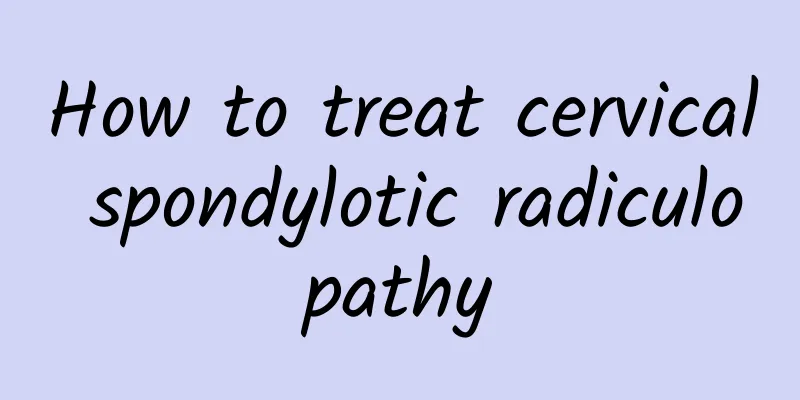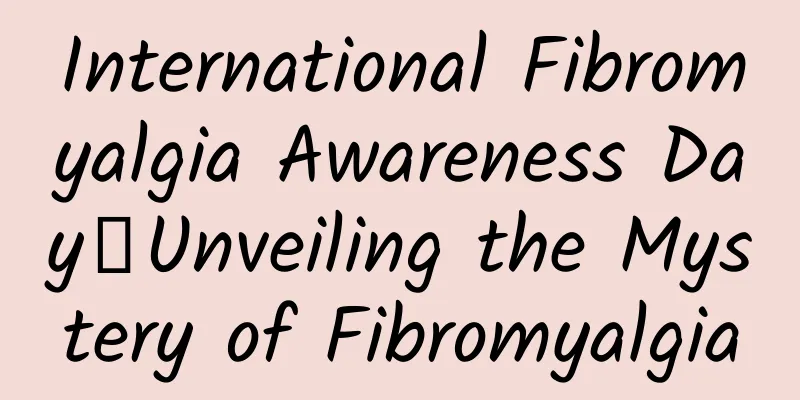How to treat cervical spondylotic radiculopathy

|
Cervical radiculopathy is the most common type of cervical spondylosis. It is caused by abnormal compression or damage of the cervical nerve roots by the surrounding tissues. The main symptoms are shoulder and neck pain, radiating pain, numbness, and fatigue to the arms and fingers. In severe cases, upper limb muscle weakness and limited mobility may occur, seriously affecting the patient's work and quality of life. This disease is more common in people aged 40 to 60 years old, with a slow onset. It is more common in people who work at a desk for a long time, motor vehicle drivers, and those who bow their heads for a long time. With the change of sedentary office and lifestyle, the incidence of this disease tends to increase and the age of onset decreases. 1. Causes and symptoms of cervical spondylotic radiculopathy Cervical radiculopathy is mainly caused by mechanical compression and inflammation of the cervical nerve roots. There are many reasons for compression, which may be acute or chronic, such as cervical disc herniation, osteophyte hyperplasia and hypertrophy of the uncovertebral joint, which can also cause local aseptic inflammatory reactions to stimulate the nerve roots and cause the disease. Typical symptoms include pain and numbness radiating from the shoulder along the upper arm to the forearm or fingers. Sometimes the pain and numbness are unbearable and seriously affect sleep. There may also be numbness/tingling of the upper limb skin, decreased muscle strength, inflexible finger movements, a sense of heaviness in the upper limbs, and decreased grip strength. Damage to different cervical nerve roots may cause symptoms in different parts of the upper limbs. When the head, neck or upper limb posture is improper, or the affected limb is suddenly hit, severe lightning-like sharp pain may occur. Neck movements, coughing, sneezing, exertion and deep breathing can also aggravate the symptoms. Muscle atrophy and fasciculations may occur in the late stage. 2. Diagnosis of cervical spondylotic radiculopathy In daily work and life, when patients have one or more of the above symptoms, they should be alert to whether they have this disease and go to a regular hospital for spinal surgery or orthopedic consultation in time. The doctor will make a clear diagnosis based on the patient's symptoms, physical examination, and imaging examinations such as cervical spine CT and cervical spine magnetic resonance imaging, and exclude other diseases such as cervical and shoulder myofasciitis, periarthritis of the shoulder, thoracic outlet syndrome, and cervical tumors, so as to provide targeted treatment. 3. Treatment of cervical spondylotic radiculopathy There are two main treatments for this disease: surgical treatment and non-surgical treatment. Conservative treatment is effective for the vast majority of patients, and only a small number of patients require surgical intervention. Patients can reasonably choose the appropriate treatment method based on their actual situation and the doctor's advice. 1. Non-surgical treatment: Non-surgical treatment is the first choice and basic treatment for cervical spondylotic radiculopathy. It can provide targeted treatment based on the characteristics of the disease and is suitable for patients with a clear diagnosis, mild symptoms or a short duration of symptoms. The main non-surgical treatment methods are as follows: (1) Neck immobilization: When the symptoms are mild or when standing, a neck brace should be worn for immobilization. When the symptoms are severe or when resting in a supine position, it is recommended to lie flat on a hard bed and use a low hard pillow. During treatment, patients should stay in bed as much as possible and reduce sitting time and neck flexion movements. The treatment period is 1 to 3 weeks. (2) Physical therapy: Continuous occipital-mandibular traction (performed in the rehabilitation department of a regular hospital, with the traction weight adjusted according to the individual patient's condition), acupuncture, infrared spectrum irradiation, paraspinal electrical stimulation therapy, etc. can improve symptoms. (3) Drug treatment: It helps to relieve the symptoms caused by radiculopathy in the acute stage and protect the damaged nerve roots. The recommended duration is 2-3 weeks. The main drugs are: ① non-steroidal anti-inflammatory analgesics (NSAIDs), COX-2 inhibitors, opioid analgesics; ② neurotrophic drugs; ③ muscle relaxants; ④ dehydration drugs; ⑤ steroid drugs; ⑥ Chinese medicine for promoting blood circulation and removing blood stasis. (4) Psychotherapy: Patients with a long course of illness, recurrent symptoms, and severe impact on normal life and sleep should be given attention and antidepressant treatment if necessary. 2. Traditional Chinese Medicine Treatment For radiculopathy, TCM takes syndrome differentiation and treatment as the starting point, and uses a combination of drugs, acupuncture, massage, cupping, scraping, etc. However, TCM treatment is mostly individualized and targeted, and its universality is relatively poor, so you should seek individualized TCM treatment from professional doctors in regular hospitals. 3. Surgical treatment: Surgery may be considered for patients with the following conditions: (1) Regular, systematic non-surgical treatment for more than three months has been ineffective, or non-surgical treatment has been effective but symptoms recur, seriously affecting daily life and work. (2) Persistent and severe radicular pain in the neck, shoulder, and arms with corresponding imaging findings, which is refractory to conservative treatment. (3) Compression of the affected nerve roots causes weakness and atrophy of the innervated muscles. There are two types of cervical spine surgery: anterior approach and posterior approach. Anterior cervical spine surgery has many advantages in treating patients with radiculopathy: easy exposure, no damage to normal tissue, less bleeding, short operation time, etc. It can directly decompress and remove bony and fibrous compression, expand the nerve root canal, and relieve nerve root compression. The main anterior cervical approach surgeries include anterior cervical discectomy, decompression and fusion, cervical disc replacement, and foraminal decompression. This surgical method is suitable for patients with symptoms caused by simple anterior pressure objects. Posterior cervical foraminotomy is another option for the treatment of cervical radiculopathy. This posterior approach avoids potential damage to important structures encountered during the anterior approach, such as the carotid and vertebral arteries, recurrent laryngeal nerve, and esophagus. Therefore, the posterior approach is more suitable for patients with a history of previous anterior surgery or abnormal anatomy. In clinical treatment, doctors will choose the appropriate surgical method based on the patient's clinical manifestations and the results of imaging examinations such as X-rays and MRIs. 4. Prognosis: Most patients can be cured by properly combining various non-surgical treatments. Even for patients who need surgery, it is essential to use various effective non-surgical treatments during the perioperative period. For patients who undergo surgery, as long as the preoperative diagnosis is clear and the correct surgical method is selected, most patients will have satisfactory results and rarely have various complications. In addition, after the operation, the patient should wear a neck collar or neck brace for 2 to 8 weeks to maintain the stability of the cervical spine; after removing the neck collar, the cervical paraspinal muscle training should be strengthened; after the operation, strenuous neck activities should be avoided to prevent neck trauma to prevent symptom recurrence; regular follow-up should be performed after the operation. A small number of patients with poor results or recurrence of symptoms after the operation may need another operation. 4. Diet for patients with radiculopathy Patients with cervical spondylosis should pay attention to their diet. Patients usually have vertebral osteophytes and decreased vertebral bone mass. Therefore, patients should eat more foods with high calcium content and protein-rich foods, such as fish, meat, eggs, milk, etc. At the same time, the most obvious symptom of cervical spondylosis is neck and shoulder pain. Taking vitamins B and E can effectively reduce pain. In addition, patients with cervical spondylosis have a large number of taboo foods, such as tobacco, alcohol, raw, cold, overly hot, greasy and other foods, which can easily aggravate the symptoms. 5. Prevention of cervical spondylotic radiculopathy From the above, we can understand that this disease is mainly caused by compression of the cervical nerve roots. Non-surgical or surgical treatment is quite effective and generally does not recur. However, cervical spondylosis should be prevented first and treated second. (1) Maintain an optimistic attitude towards life. (2) Change bad posture: To prevent the occurrence of cervical spondylosis, the most important thing is to correct the lifestyle and posture. An unhealthy lifestyle, such as bowing the head for a long time, can lead to cervical flexion, paravertebral muscle tension, excessive blood vessel contraction and other problems. When sitting, the waist and back should be kept vertical and slightly leaned on the backrest. The height of the chair should be level with the calf height, and the height of the desktop screen should be level with the sitting position. Office workers should get up and walk every hour to relax the neck and shoulders, and never sit for a long time. The time of bowing the head to use the mobile phone should be shortened as much as possible, and the eyes should be kept level with the phone as much as possible. In addition, head and neck trauma, emergency braking, dozing off in the car, and sleeping with a high pillow should be avoided. (3) Eating habits: Eat more foods containing vitamins and proteins. These substances can not only provide patients with adequate nutrition, but also promote bone and muscle metabolism and promote recovery from the disease. Smoking, alcohol and obesity have also been found to be related to spinal diseases, so quitting smoking and drinking and maintaining a normal weight are equally important. (4) Regularly relax and strengthen the neck and shoulder muscles, such as back tension band structure exercises, etc. You can also do activities such as flying kites, swimming, and playing badminton. Figure 1: Gently retract your chin and feel the back of your neck contract to its maximum. Repeat 10 times. Figure 2: Tilt your head back and try to lift your chin as high as possible. Repeat 10 times. Figure 3: Press the head lightly to the same side with both hands, alternating between the two hands 5 times each. Figure 4: With your hands and shoulders lowered, turn your head to one side as far as possible, 5 times on each side. Figure 5: Tilt your head back and press forward with both hands behind your head. Stop when you feel a stretch at the back of your neck. Repeat 5 times. Figure 6: Open both upper limbs 90 degrees, contract the back muscles and feel the shoulder blades tighten on both sides, repeat 5 times. Figure AD: Gently press the head on the same side with your hand, gradually and gently apply force, from neutral position to maximum lateral deviation, alternating between the two sides, 5 times each. Figure E: Press your forehead lightly with your hands, then gradually apply gentle force, with your hands and head working against each other, from the highest position when your head is tilted back to the lowest position when your head is tilted back, and repeat 5 times. Figure F: Press your forehead lightly with your hands, then gradually apply gentle force, with your hands and head working against each other, from the lowest position when lowering your head to the highest position when raising your head, and repeat 5 times. Figure G: Cross your hands behind your head, gradually and gently apply force, with your hands and head working against each other, from the lowest position of lowering your head to the highest position of raising your head, and repeat 5 times. Figure H: Cross your hands behind your head, gradually and gently apply force, with your hands and head working against each other, from the highest position of raising your head to the lowest position of lowering your head, and repeat 5 times. (5) Keep your neck and shoulders warm and protect them from wind, cold and moisture. (6) Actively treat local infections and promptly and thoroughly treat soft tissue strain of the neck, shoulders and back. (7) If you experience neck and shoulder discomfort in the early stages, go to a regular hospital to consult a specialist, get a clear diagnosis, and intervene in the disease at an early stage. Author: Huang Yufeng Unit: Department of Spine Surgery, Oriental Hospital Affiliated to Tongji University Zip code: 200120 |
Recommend
What to do if morning sickness is severe and bloodshot
Morning sickness is a common symptom of pregnancy...
What should I do if my menstruation comes early every time?
Menstruation is a normal physiological phenomenon...
What to do if a pregnant woman gets angry? How to reduce the fire
If the temperature is too dry, many people are li...
No vaginal elasticity
Research has found that prolonged sexual intercou...
There is a hard lump on the edge of the breast that hurts
The breast is an important part of the female bod...
Does Tai Chi have any practical use? Why do many Tai Chi forms have no practical use?
Tai Chi is a martial arts sport that conforms to ...
How to regulate menstruation when it comes every two or three months
Abnormal menstruation is a condition that current...
What should pregnant women do if their mouths are dry and flaky?
Now we have entered the season of clear and cool ...
Can I have sex 26 days after taking medicine to induce abortion?
Abortion is a solution that many people take for ...
What kind of exercise can I do during my period?
Many female friends cannot do anything during thi...
What should women eat after giving birth?
Giving birth is a very painful process, but it is...
How effective is moxibustion sticks in treating gynecological diseases?
At present, gynecological diseases deeply trouble...
Can pregnant women drink coffee? After seeing these, do you still dare to drink?
Women become relatively vulnerable after becoming...
The small bean on the female urethra
Small pimples on the female urethra are mainly ca...









